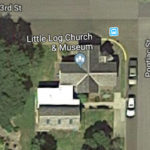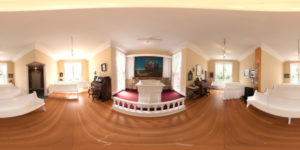
This is the Little Log Church By The Sea in Yachats, Oregon.
This is the interior of the Little Log Church By The Sea in Yachats, Oregon. It was built circa 1930 and operated as a church until 1968, at which point the congregation had to move to larger quarters and the building was donated as a museum. It is still a museum, with an attached building that houses historical artifacts associated with the church, displays about local history, and other interesting collections.
One of the interesting things about the original church building is that the overall shape is that of a cross. This used to be more common than it is today. The shape is clearly visible in Google Maps:

This seemed like an interesting location for a VR because of the unique interior layout. Capturing the cross shape from the inside would be hard to do with a normal photograph, but using a 360 degree picture allows one to look around and get the whole scene.
Stitching the photo was pretty easy, although it did require a separate picture for the downward shot. The floor was not something that could be Photoshopped out because of the unique pattern of the floorboards.
While most of the interior exposure was nicely balanced, the windows were problematic. I took multiple exposures, but used only one to get this picture. Even so, it did take some processing to keep the windows from being overexposed while still allowing the interior to look nice.
It would also be possible to use multiple pictures, showing the interior from several different angles. In this case, the viewer has to mentally join them together into a single layout. This is possible, but is not a natural way to view the scene.
Another option would be to use a very wide angle lens to capture large swaths, perhaps even the whole space, and display it as a single flat picture. However, there’s no way to do this without creating severe distortion. The result can be seen with a single glance, but looks warped and unnatural, like this:

A VR photo allows someone to experience the space in a natural manner, simply by moving around. A person can look whichever direction they want in order to fully see the space, by moving smoothly from one part to another in a way that we are already used to.
Note that viewing a VR photo involves moving it around and interacting with it. Flat photos can be viewed without any interaction, but not spherical ones. The tradeoff involved with seeing completely is that you need to be active. Whether it’s clicking and dragging on a screen, or turning your head while wearing VR goggles, you can’t just sit passively and expect to see everything.
Maybe this is a way to think of transcendent things. Could it be that it takes effort, involvement, some sort of interaction, to see everything? And interactivity looks different for transcendent things than natural material things. Hard to say what we should expect — meditation, prayer and fasting, charity, specific book learning, something else? Not sure, but wanting it to look like everything else in our lives seems unreasonable.
Regardless, the metaphor suggests that we need to actively seek the truth, we need to deliberately open our eyes and look around. We can’t sit passively and expect to see clearly, and if we don’t see clearly then it’s easy to conclude that there’s nothing there. The passive approach becomes a self-fulfilling opinion as dogmatism takes over and one believes everything is explained.
Regarding the transcendent or spiritual, what might the wrong lens look like? Certainly dogmatic naturalism, an abject refusal to look around, is one possibility. But could religion be problematic? Perhaps. Maybe it can be an example of the wrong lens, trying to experience all of reality through a single set of experiences. In other words, thinking that the transcendent is only a matter of religious activities, rather than all aspects of life. Then trying to force a relationship outside of the religious activities distorts the truth.
I don’t know, but that seems like a promising start. Using metaphors like this is an interesting way to explore the questions. Maybe it would help to do it more.